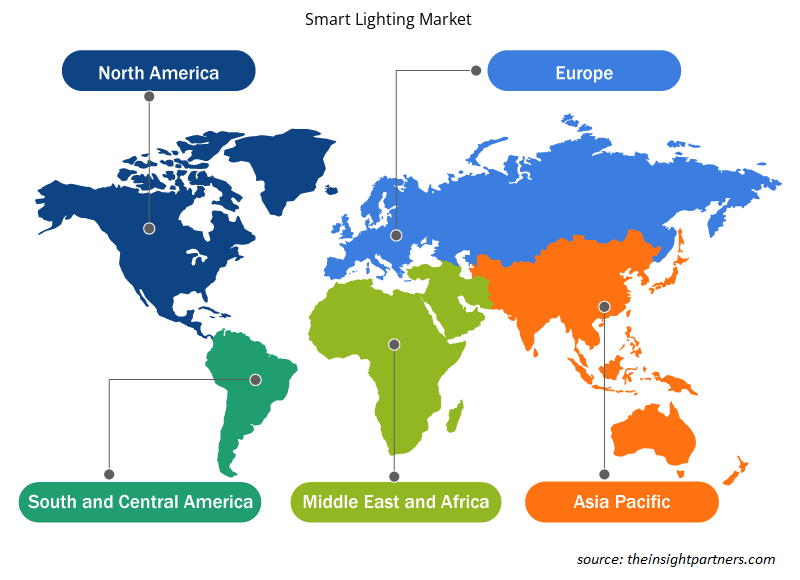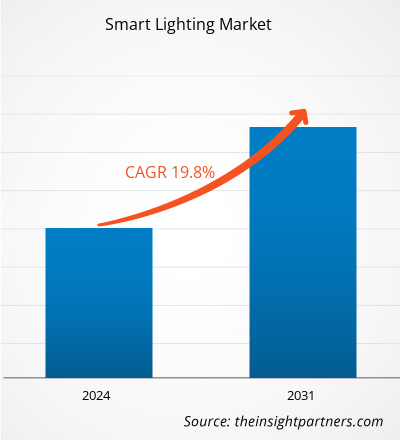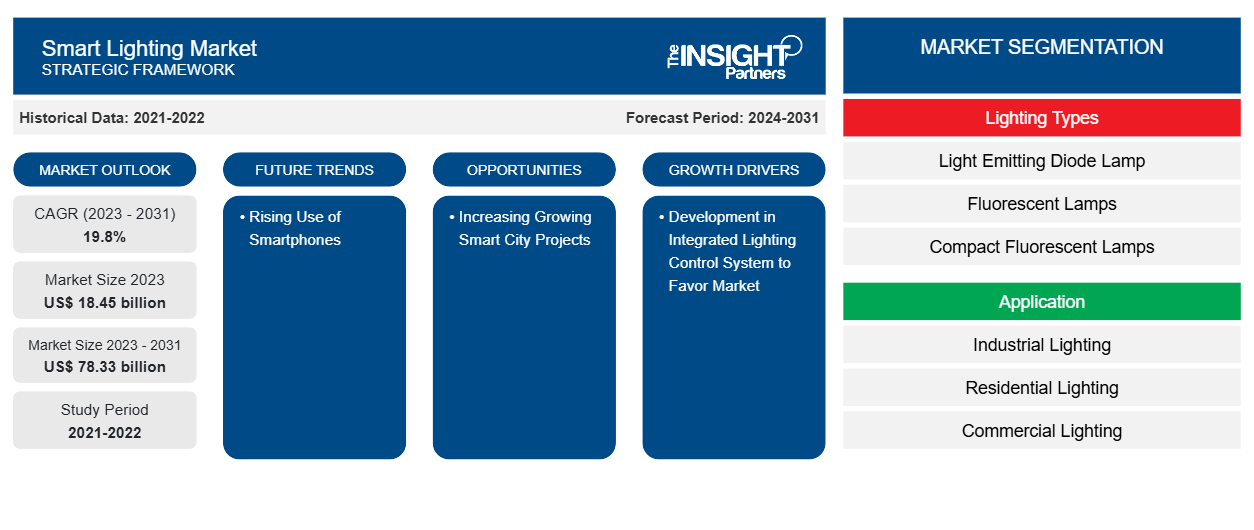Si prevede che la dimensione del mercato dell'illuminazione intelligente raggiungerà i 78,33 miliardi di dollari entro il 2031, rispetto ai 18,45 miliardi di dollari del 2023. Si prevede che il mercato registrerà un CAGR del 19,8% nel 2023-2031. Lo sviluppo di sistemi di controllo dell'illuminazione integrati e la crescita dei progetti di città intelligenti rimarranno probabilmente le principali tendenze del mercato dell'illuminazione intelligente.
Analisi del mercato dell'illuminazione intelligente
Il mercato dell'illuminazione intelligente sta crescendo a un ritmo rapido. Negli ultimi anni, il mercato dell'illuminazione intelligente ha sperimentato una crescita sostanziale grazie ai progetti di smart city in corso e futuri nelle economie in via di sviluppo.
Panoramica del mercato dell'illuminazione intelligente
Le luci sono diventate più popolari e richieste sia in ambienti commerciali che residenziali grazie alla loro capacità di collegarsi a dispositivi Internet of Things e produrre una gamma di illuminazione ambientale con semplici smartphone o tablet. Se necessario, le luci intelligenti possono essere oscurate in una varietà di tonalità di colore. Possono anche essere collegate tramite Wi-Fi, Bluetooth, SmartThings, Z-Wave o ZigBee e possono essere programmate per accendersi o spegnersi. Inoltre, il controllo vocale sulle luci intelligenti può essere ottenuto tramite l'integrazione di piattaforme, come Google Assistant, Microsoft Cortana, Apple Siri e Amazon Alexa. Oltre all'illuminazione, questi ampi set di funzionalità includono anche un numero crescente di dispositivi IoT e piattaforme di assistenti intelligenti, che hanno aperto nuove opportunità di crescita per il mercato dell'illuminazione intelligente.
Personalizza questo report in base alle tue esigenze
Riceverai la personalizzazione gratuita di qualsiasi report, comprese parti di questo report, o analisi a livello nazionale, pacchetto dati Excel, oltre a usufruire di grandi offerte e sconti per start-up e università
-
Scopri le principali tendenze di mercato in questo rapporto.Questo campione GRATUITO includerà analisi di dati che spaziano dalle tendenze di mercato alle stime e alle previsioni.
Driver e opportunità del mercato dell'illuminazione intelligente
Sviluppo del sistema di controllo dell'illuminazione integrato per favorire il mercato
L'accensione e lo spegnimento sono resi possibili dal sistema di controllo integrato da un'unica postazione. L'economicità dell'illuminazione intelligente e la maggiore consapevolezza tra consumatori e governo della necessità di risparmiare elettricità stanno contribuendo alla sua quota di mercato in espansione. Il mercato dell'illuminazione intelligente è stato in grado di crescere a livello globale grazie allo sviluppo di sistemi di controllo dell'illuminazione integrati.
Progetti di città intelligenti in crescita
Poiché i dispositivi di illuminazione intelligente sono sempre più utilizzati come risultato dei progetti di smart city in corso, si prevede che il mercato mondiale dell'illuminazione intelligente crescerà in modo significativo. I governi dei paesi in via di sviluppo stanno effettuando grandi investimenti finanziari nella creazione di smart city. Per numerosi fornitori nei settori della consulenza, dei servizi di pubblica utilità e dell'informatica, ciò offre un'opportunità commerciale sostanziale. Poiché massimizzare l'uso dell'elettricità disponibile è uno degli obiettivi principali dello sviluppo di smart city e poiché l'illuminazione intelligente sta diventando sempre più popolare per la sua efficienza, l'illuminazione intelligente è coerente con i progetti di smart city. Si prevede che l'implementazione dell'illuminazione intelligente aiuterà in modo significativo il risparmio energetico e la sostenibilità.
Analisi della segmentazione del rapporto di mercato dell'illuminazione intelligente
I segmenti chiave che hanno contribuito alla derivazione dell'analisi di mercato dell'illuminazione intelligente sono i tipi di illuminazione, le applicazioni e la tecnologia di connettività.
- In base ai tipi di illuminazione, il mercato dell'illuminazione intelligente è suddiviso in lampade a diodi ad emissione luminosa (LED), lampade fluorescenti, lampade fluorescenti compatte (CFL), lampade a scarica ad alta intensità e altre (lampade al neon e flash fotografici). Il segmento LED ha detenuto una quota di mercato maggiore nel 2023.CFL), high-intensity discharge lamps, and others (neon lamps and photographic flashes). The LED segment held a larger market share in 2023.
- In base alle dimensioni dell'applicazione, il mercato è segmentato in illuminazione industriale, illuminazione residenziale, illuminazione commerciale, governo, illuminazione esterna e illuminazione automobilistica. Il segmento residenziale ha detenuto la quota maggiore del mercato nel 2023.
- In base alla tecnologia di connettività, il mercato dell'illuminazione intelligente è diviso in cablato e wireless. Il segmento wireless ha detenuto una quota di mercato maggiore nel 2023.
Analisi della quota di mercato dell'illuminazione intelligente per area geografica
L'ambito geografico del report Smart Lighting Market è principalmente suddiviso in cinque regioni: Nord America, Asia Pacifico, Europa, Medio Oriente e Africa e Sud America/Sud e Centro America. Il Nord America ha dominato il mercato dell'illuminazione intelligente. Le tendenze di adozione di tecnologie elevate in vari settori della regione hanno alimentato la crescita del mercato dell'illuminazione intelligente. Si prevede che fattori come l'adozione crescente di strumenti digitali e l'elevata spesa tecnologica da parte delle agenzie governative guideranno la crescita del mercato dell'illuminazione intelligente del Nord America. Inoltre, una forte enfasi sulla ricerca e sviluppo nelle economie sviluppate sta costringendo gli operatori nordamericani a portare sul mercato soluzioni tecnologicamente avanzate. Tutti questi fattori contribuiscono alla crescita del mercato dell'illuminazione intelligente della regione.
Approfondimenti regionali sul mercato dell'illuminazione intelligente
Le tendenze regionali e i fattori che influenzano il mercato dell'illuminazione intelligente durante il periodo di previsione sono stati ampiamente spiegati dagli analisti di Insight Partners. Questa sezione discute anche i segmenti e la geografia del mercato dell'illuminazione intelligente in Nord America, Europa, Asia Pacifico, Medio Oriente e Africa e America meridionale e centrale.

- Ottieni i dati specifici regionali per il mercato dell'illuminazione intelligente
Ambito del rapporto sul mercato dell'illuminazione intelligente
| Attributo del report | Dettagli |
|---|---|
| Dimensioni del mercato nel 2023 | 18,45 miliardi di dollari USA |
| Dimensioni del mercato entro il 2031 | 78,33 miliardi di dollari USA |
| CAGR globale (2023-2031) | 19,8% |
| Dati storici | 2021-2022 |
| Periodo di previsione | 2024-2031 |
| Segmenti coperti |
Per tipo di illuminazione
|
| Regioni e Paesi coperti |
America del Nord
|
| Leader di mercato e profili aziendali chiave |
|
Densità degli attori del mercato dell'illuminazione intelligente: comprendere il suo impatto sulle dinamiche aziendali
Il mercato dell'illuminazione intelligente sta crescendo rapidamente, spinto dalla crescente domanda degli utenti finali dovuta a fattori quali l'evoluzione delle preferenze dei consumatori, i progressi tecnologici e una maggiore consapevolezza dei vantaggi del prodotto. Con l'aumento della domanda, le aziende stanno ampliando le loro offerte, innovando per soddisfare le esigenze dei consumatori e capitalizzando sulle tendenze emergenti, il che alimenta ulteriormente la crescita del mercato.
La densità degli operatori di mercato si riferisce alla distribuzione di aziende o società che operano in un particolare mercato o settore. Indica quanti concorrenti (operatori di mercato) sono presenti in un dato spazio di mercato in relazione alle sue dimensioni o al valore di mercato totale.
Le principali aziende che operano nel mercato dell'illuminazione intelligente sono:
- Significare Holding
- Legrand Nord America, LLC
- MARCHI ACUITY, INC.
- Lutron Electronics Co., Inc
- Leviton Manufacturing Co., Inc
- Zumtobel
Disclaimer : le aziende elencate sopra non sono classificate secondo un ordine particolare.

- Ottieni una panoramica dei principali attori del mercato dell'illuminazione intelligente
Notizie e sviluppi recenti del mercato dell'illuminazione intelligente
Il mercato dell'illuminazione intelligente viene valutato raccogliendo dati qualitativi e quantitativi dopo la ricerca primaria e secondaria, che include importanti pubblicazioni aziendali, dati associativi e database. Di seguito è riportato un elenco degli sviluppi nel mercato:
- Nel febbraio 2023, Signify, uno dei leader mondiali nell'illuminazione, ha fornito illuminazione stradale a LED, pali intelligenti e un sistema di illuminazione connesso ai parchi industriali di Huanggang City nella provincia di Hubei, in Cina. Questo progetto di palo intelligente su larga scala consentirà alla provincia di risparmiare sui costi energetici e sulle emissioni, digitalizzando al contempo l'infrastruttura urbana.
(Fonte: Signify, Comunicato stampa, 2023)
- Nel novembre 2023, per collegarsi meglio e in modo fluido alla piattaforma Smart IoT e fornire un'interazione intelligente più comoda per gli utenti, Yeelight, in qualità di fornitore di soluzioni autorevole nel campo dell'illuminazione intelligente, ha lanciato ufficialmente una soluzione aggiornata basata sulla configurazione fluida del protocollo BLE Mesh per produttori e marchi.
(Fonte: Yeelight, Comunicato stampa, 2023)
Copertura e risultati del rapporto sul mercato dell'illuminazione intelligente
Il rapporto "Dimensioni e previsioni del mercato dell'illuminazione intelligente (2021-2031)" fornisce un'analisi dettagliata del mercato che copre le seguenti aree:
- Dimensioni del mercato e previsioni a livello globale, regionale e nazionale per tutti i principali segmenti di mercato interessati dall'indagine.
- Dinamiche di mercato come fattori trainanti, vincoli e opportunità chiave
- Principali tendenze future
- Analisi dettagliata delle cinque forze PEST/Porter e SWOT
- Analisi del mercato globale e regionale che copre le principali tendenze del mercato, i principali attori, le normative e i recenti sviluppi del mercato.
- Analisi del panorama industriale e della concorrenza che comprende la concentrazione del mercato, l'analisi delle mappe di calore, i principali attori e gli sviluppi recenti.
- Profili aziendali dettagliati
- Analisi storica (2 anni), anno base, previsione (7 anni) con CAGR
- Analisi PEST e SWOT
- Valore/volume delle dimensioni del mercato - Globale, Regionale, Nazionale
- Industria e panorama competitivo
- Set di dati Excel
Report recenti
Testimonianze
Motivo dell'acquisto
- Processo decisionale informato
- Comprensione delle dinamiche di mercato
- Analisi competitiva
- Analisi dei clienti
- Previsioni di mercato
- Mitigazione del rischio
- Pianificazione strategica
- Giustificazione degli investimenti
- Identificazione dei mercati emergenti
- Miglioramento delle strategie di marketing
- Aumento dell'efficienza operativa
- Allineamento alle tendenze normative























 Ottieni un campione gratuito per - Mercato dell'illuminazione intelligente
Ottieni un campione gratuito per - Mercato dell'illuminazione intelligente